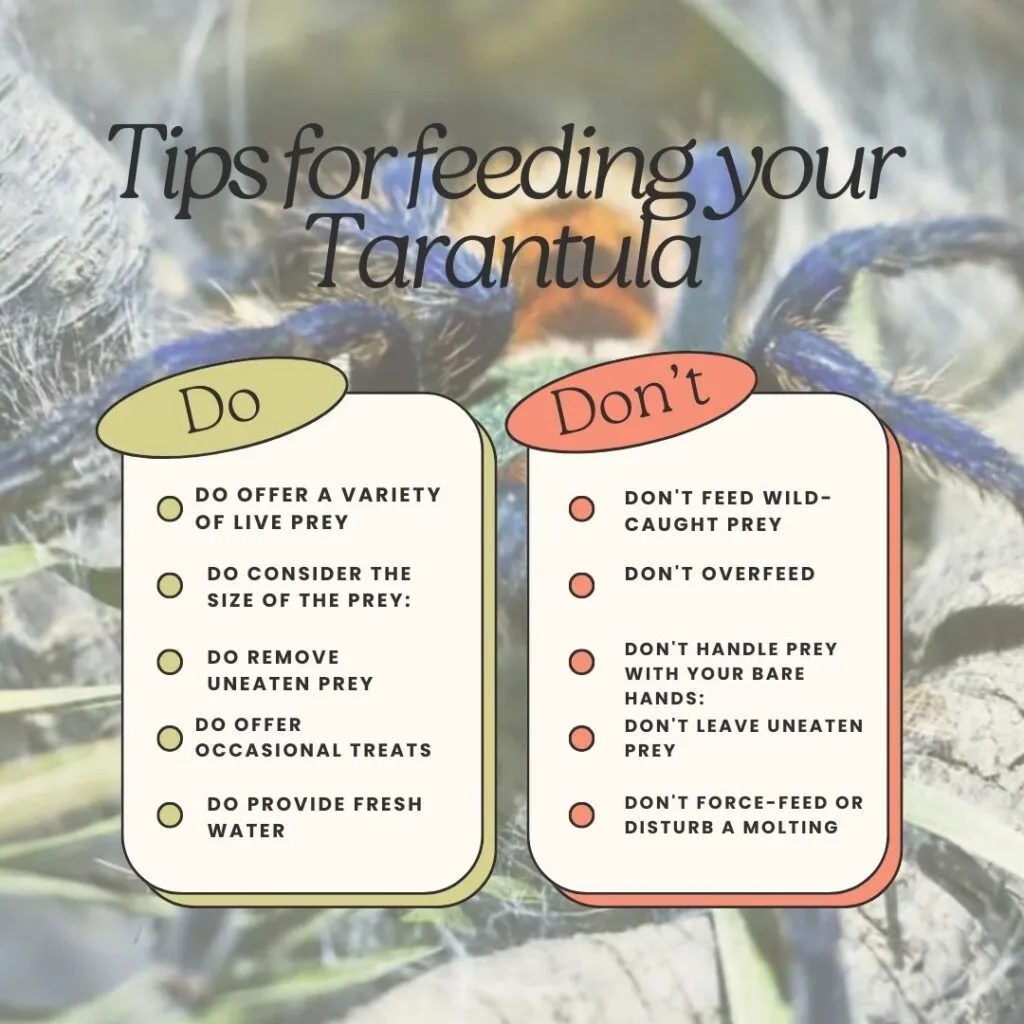Owning a tarantula can be an incredibly rewarding experience, but their unique needs require specific care, especially concerning their diet. Understanding your tarantula’s dietary requirements is crucial for their health, longevity, and overall well-being. From the types of insects they consume to the frequency of feeding and the importance of hydration, this guide will provide you with the top 5 must-know facts about your tarantula’s diet. Proper nutrition and care will ensure your eight-legged friend thrives.
What Do Tarantulas Eat
The cornerstone of a tarantula’s diet is insects. In the wild, they are opportunistic predators, consuming whatever insects they can catch. In a captive environment, you’ll be responsible for providing them with a balanced diet that meets their nutritional needs. It’s important to offer a variety of insects to ensure they receive a range of nutrients. Avoid feeding them insects that have been exposed to pesticides, as this can be fatal to your tarantula. The best practice is to source feeder insects from a reputable pet store or breeder, ensuring their safety and nutritional value.
Insects as Primary Food Source
Insects are the primary food source for tarantulas, mimicking their natural diet in the wild. They are voracious hunters, using their fangs to inject venom and subdue their prey. The type of insect you offer can influence the overall health and development of your tarantula. Variety is key, but there are a few insects that form the backbone of a healthy tarantula diet. Ensure that the insects are gut-loaded before feeding them to your tarantula. This involves feeding the insects a nutritious diet before offering them as food, which helps to transfer essential vitamins and minerals to your tarantula.
Crickets
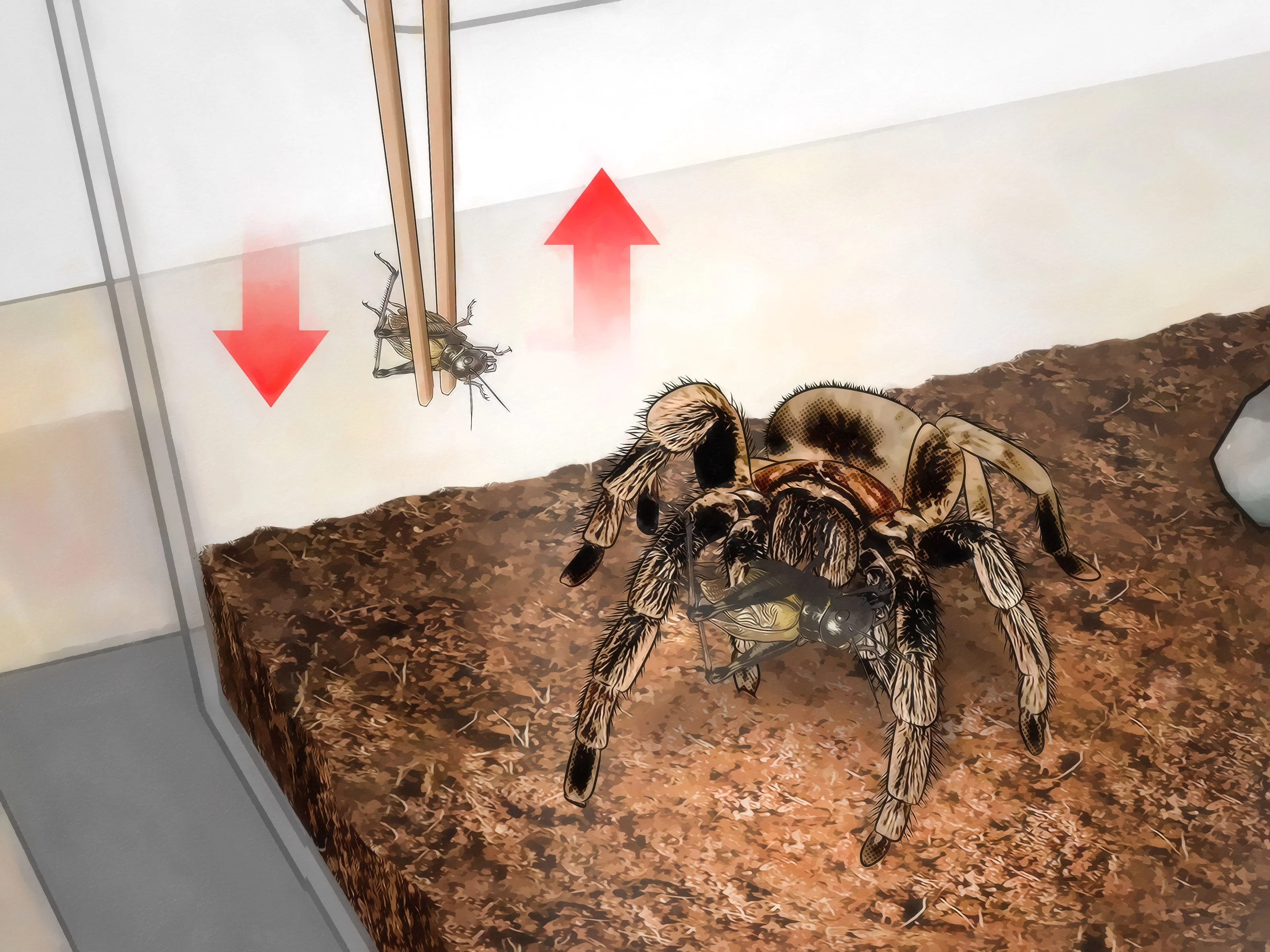
Crickets are a readily available and popular food choice for tarantulas. They are easy to breed and maintain, and their size can be easily matched to the size of your tarantula. However, crickets don’t offer as much nutrition as some other options, and they can be a bit noisy. Ensure that the crickets are gut-loaded with a diet rich in vitamins and minerals before feeding them to your tarantula. This helps to maximize the nutritional value that your tarantula receives. Be sure to remove any uneaten crickets from the enclosure, as they can stress your tarantula by constantly biting or disturbing it. (Image: tarantula-eating-cricket.webp)
Roaches
Roaches, such as Dubia roaches, are a superior food source compared to crickets. They are higher in protein and have a better nutritional profile. They are also less noisy and easier to keep. Roaches are slower and less likely to hide from your tarantula, making them a more straightforward feeding option. Gut-loading roaches is equally important; feed them a nutritious diet to boost their vitamin and mineral content. This will provide your tarantula with a more well-rounded meal, promoting healthy growth and development. (Image: tarantula-eating-roach.webp)
Mealworms
Mealworms can be part of your tarantula’s diet, but they are not as nutritionally complete as other insects. They have a high-fat content, so they should be offered sparingly. Mealworms are easy to store and can be a convenient option. Ensure that the mealworms you offer are from a reputable source to avoid any potential health risks. Use mealworms as a treat or supplement rather than the primary food source to maintain a balanced diet for your tarantula. Overfeeding mealworms can lead to obesity and other health complications.
Other Insects

Besides the insects mentioned above, you can occasionally offer your tarantula other types of insects. These can include grasshoppers, waxworms (as treats), and other commercially available insects. The key is to vary the diet to provide a wide range of nutrients. The insect size should correspond with the size of your tarantula. Too large, and your tarantula might be intimidated. The insect should be smaller than the tarantula’s body size. This provides your tarantula with ease when hunting for its meal and reduces potential risks such as a counter-attack from the insect.
Feeding Frequency and Schedule
The feeding frequency for your tarantula varies depending on its age and size. Young tarantulas require more frequent feedings to support their rapid growth. As tarantulas mature, their metabolism slows down, and they need to eat less often. It’s crucial to establish a feeding schedule that suits your tarantula’s needs while considering its appetite and overall health. Overfeeding can lead to health problems, while underfeeding can stunt growth. Adjust your feeding schedule based on the tarantula’s individual characteristics and its molting cycle.
How Often to Feed
Young tarantulas (spiderlings) typically need to be fed every other day or every day. Subadult tarantulas (those nearing adulthood) can be fed 2-3 times a week. Adult tarantulas often only need to be fed once a week or even every other week. The specific schedule will depend on the species, size, and individual metabolism of your tarantula. Always observe your tarantula’s behavior. If it consistently refuses food, it might be preparing to molt, or it might be overfed. (Image: tarantula-habitat.webp)
Feeding Young Tarantulas
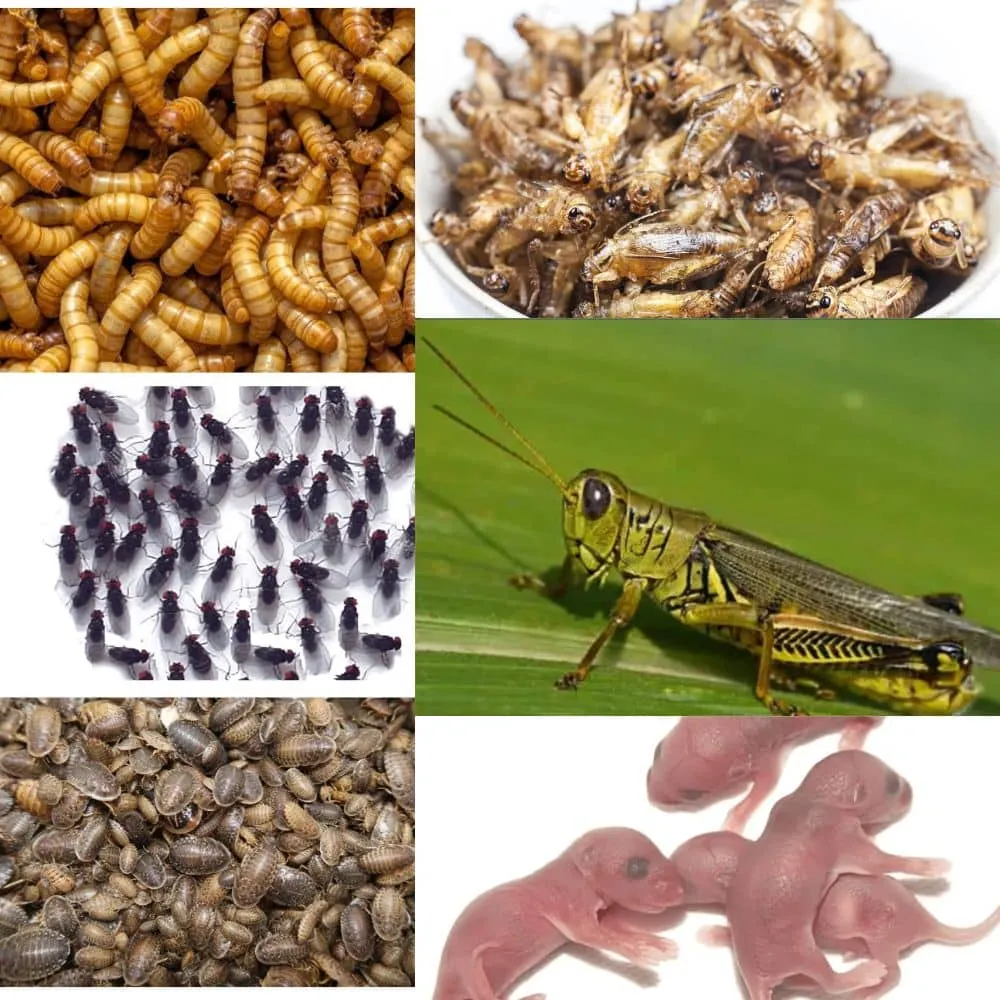
Young tarantulas require a more frequent feeding schedule compared to adults. This is because they are growing rapidly and need the extra energy and nutrients to develop properly. The ideal feeding schedule would be to feed spiderlings daily or every other day. The food should be appropriately sized for their small bodies. Overfeeding young tarantulas can be detrimental, so closely monitor the food intake and adjust accordingly. Provide a consistent supply of small, gut-loaded insects to encourage healthy growth. (Image: tarantula-size-comparison.webp)
Feeding Adult Tarantulas
Adult tarantulas generally require less frequent feeding. They have a slower metabolism and a different set of needs. Feeding once a week is often sufficient. Some adult tarantulas may only need to be fed every other week, depending on their size, species, and the amount of food they consume. Avoid overfeeding as it can stress the tarantula and lead to health issues. Also, the size of the food should be appropriate. Adult tarantulas can handle larger prey items, but ensure they can successfully capture and consume them. Adjust the feeding schedule depending on your tarantula’s activity levels and molting cycle.
Importance of Water and Hydration
Water is an essential aspect of your tarantula’s diet and overall well-being. Tarantulas need access to fresh, clean water at all times to stay hydrated and healthy. Dehydration can lead to serious health problems, including molting difficulties and even death. Provide a shallow water dish that the tarantula can easily access without the risk of drowning. Regularly clean and refill the water dish to prevent the growth of bacteria and keep the water fresh. Monitoring your tarantula’s hydration is critical to its well-being. (Image: tarantula-water-dish.webp)
Proper Hydration Techniques
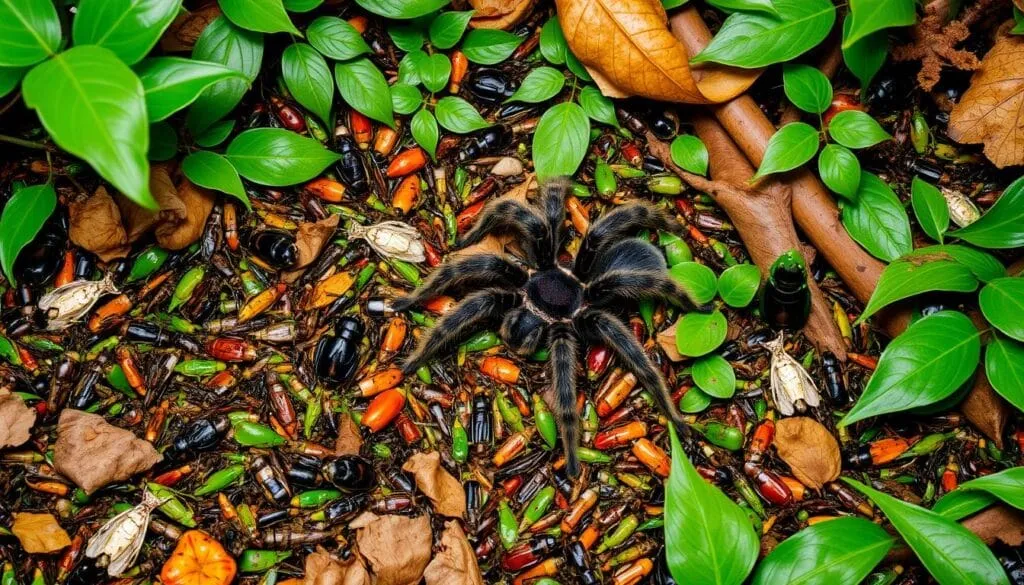
The key to proper hydration is a constant supply of fresh water. Use a shallow water dish, which is usually a bottle cap or a small, stable dish. Change the water frequently, ideally every day or two, to prevent the accumulation of debris and the growth of bacteria. In dry environments, you might also need to mist the enclosure lightly to increase humidity levels. Ensure that you do not over-mist, as this can lead to mold and other issues. Observe your tarantula’s behavior for signs of dehydration, such as lethargy or difficulty molting.
Water Bowl Maintenance
Maintaining the water bowl is crucial for hygiene and tarantula health. Clean the water bowl regularly using warm water and mild soap, rinsing thoroughly to remove any residue. If you notice any algae or debris, clean the bowl immediately. Avoid using harsh chemicals or detergents, as they can be harmful to your tarantula. Always place the water bowl in a secure location where the tarantula can easily access it. The location is key for hydration. The water bowl will help maintain humidity levels in the enclosure as well as give a direct hydration source. (Image: tarantula-species.webp)
Nutritional Needs
While insects form the bulk of a tarantula’s diet, certain nutritional considerations can optimize their health. Tarantulas require essential nutrients like calcium and vitamins to support various bodily functions, including growth, molting, and overall well-being. Ensuring these nutrients are adequate will promote robust health and a longer lifespan for your tarantula. You can achieve these nutritional needs through supplementation and proper food choices. A balanced diet will keep your tarantula happy and healthy.
Calcium and Vitamins
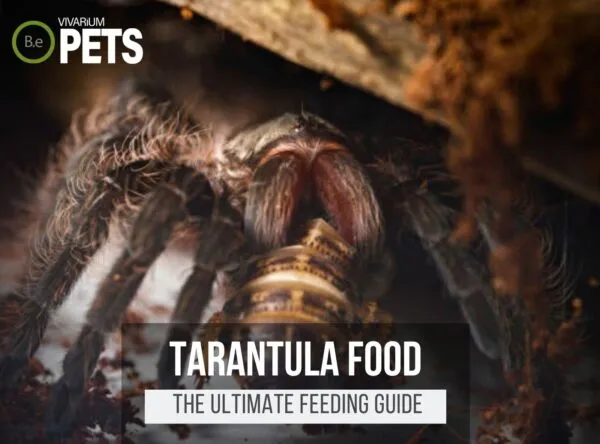
Calcium is crucial for the exoskeleton development of a tarantula, and vitamins help with various metabolic processes. Calcium helps ensure strong and healthy exoskeletons, while vitamins such as Vitamin D3 aid in calcium absorption. The ideal diet for the tarantula should contain the essential vitamins. Gut-loading feeder insects with calcium-rich diets and vitamin supplements is a good way to provide these essential nutrients. The use of a calcium supplement can be done, but it is not as critical as offering insects with the correct vitamins. Consult a veterinarian or experienced tarantula keeper if you have concerns about your tarantula’s vitamin and calcium intake.
Supplementation
Supplementation can be essential to your tarantula’s diet. Dusting feeder insects with a calcium and vitamin supplement before feeding can help to ensure they receive adequate nutrients. Some keepers also provide vitamin supplements in the water dish, but this is less effective than dusting the insects. The supplementation will depend on the diet you are providing, and it will need to be taken into consideration. Always follow the manufacturer’s instructions when using supplements. A varied diet, including gut-loaded insects, will often provide sufficient nutrition for most tarantulas. Consult with an expert to decide the best supplementation practices for your specific tarantula species.
Things to Avoid Feeding Your Tarantula
Not everything is safe to feed your tarantula. Certain foods can be toxic or harmful, leading to serious health problems. It’s essential to understand what to avoid to protect your tarantula’s well-being. Always research the specific dietary needs of your tarantula species. Some foods can cause digestive problems or other health complications. This includes any insects collected from the wild, as they can carry parasites or diseases. Be diligent about avoiding foods that pose a risk to your tarantula’s health.
Toxic Foods
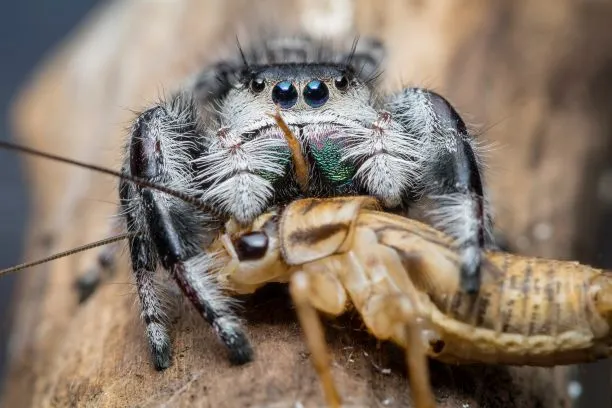
Certain foods are toxic to tarantulas and should be avoided at all costs. Never feed your tarantula anything that has been exposed to pesticides or chemicals. Also, avoid feeding it any insects collected from the wild, as they may have ingested harmful substances. Some human foods, like processed meats, dairy products, and sugary treats, are not appropriate for tarantulas and can lead to health issues. Stick to a diet of appropriately sized, gut-loaded insects, and you will significantly minimize the risk of exposure to toxic substances. Always be cautious about anything that could potentially harm your tarantula. (Image: tarantula-molting.webp)
Overfeeding Dangers
Overfeeding can be detrimental to a tarantula’s health. Obesity can lead to various health problems, including a shortened lifespan. Overfed tarantulas can also have difficulty molting and may experience reduced activity levels. Adjust the feeding schedule based on your tarantula’s age, size, and activity level. Observe its behavior, and if it seems overly full or sluggish, reduce the amount of food or the frequency of feedings. Always ensure that your tarantula is eating, and don’t overfeed, as this may result in health problems and an early passing.
Special Considerations
Certain situations require special considerations when feeding your tarantula. The molting cycle, for instance, significantly impacts its appetite and feeding habits. Also, seasonal changes might affect the tarantula’s metabolism, requiring adjustments to its diet. Understanding these special situations is crucial to providing optimal care. The diet and feeding schedule should be adjusted based on the tarantula’s individual needs and overall health.
Molting and Appetite Changes

During the molting process, tarantulas often lose their appetite. They may refuse food for weeks or even months before a molt. It’s normal for them to become less active during this period. Do not force-feed your tarantula if it isn’t eating. Offer food, but remove it after a day or two if it is not consumed. After molting, tarantulas typically have a voracious appetite as they need to rebuild their energy reserves. It’s important to feed a high-protein diet after molting to aid in recovery. (Image: tarantula-molting.webp)
Seasonal Adjustments
Seasonal changes can also influence a tarantula’s feeding habits. During warmer months, tarantulas are generally more active and may have a higher metabolism, requiring more food. During colder months, their metabolism slows down, and they may eat less. The seasonal diet can be adjusted based on the temperature and humidity levels in the enclosure. Adjust the feeding schedule and the amount of food based on your observation of your tarantula. Maintain a consistent environment and provide appropriate heat and humidity levels to help manage its needs.
In conclusion, understanding your tarantula’s dietary needs is vital for ensuring its health and longevity. From the insects you choose to the feeding schedule you maintain, every aspect of its diet contributes to its well-being. By following the top 5 must-know facts discussed, you can create a thriving environment for your tarantula, promoting healthy growth, and a long, happy life. Remember to always research the specific needs of your tarantula species and consult with experienced keepers or a veterinarian for personalized advice. With the right care, your tarantula can be a fascinating and rewarding pet for many years to come.
